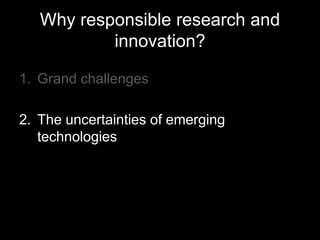Against excellence
- 8. âDoing high quality research is hard and there needs to be a clear focus on excellence, generally best assessed by highly accomplished researchers in the relevant field.â
- 9. âA clearly thought through and acceptable pathways to impact is an essential component of a research proposal and a condition of funding. Applicants are required to use this section of the proposal to identify the potential impact of their work and to outline the steps they can sensibly make now to facilitate the realisation of those impactsâĶ If a proposal is ranked high enough to be funded but does not have an acceptable Pathways to Impact it will be returned.â
- 11. Excellence and relevance are drifting further apart
- 15. Responsible research and innovation in Horizon 2020
- 16. Why responsible research and innovation? 1. Grand challenges 2. The uncertainties of emerging technologies
- 17. Why responsible research and innovation? 1. Grand challenges 2. The uncertainties of emerging technologies
- 20. âI am optimistic enough about this that I am willing to make a prediction. By 2035, there will be almost no poor countries left in the world.â Bill Gates, 2014
- 21. âThis disparity between rich and poor has been noticedâĶ Whatever else survives to the year 2000, that wonât.â CP Snow, The Two Cultures, 1959
- 24. âIn the future, people will spend less time trying to get technology to work ... If we get this right, I believe we can fix all the worldâs problems.â Eric Schmidt, Google âThere are a lot of really big issues for the world that need to be solved and, as a company, what we are trying to do is to build an infrastructure on top of which to solve some of these problems.â Mark Zuckerberg, Facebook
- 25. Pope Francis, World Economic Forum, Davos, 2014 âThose who have demonstrated their aptitude for being innovative and for improving the lives of many people by their ingenuity and professional expertise can further contribute by putting their skills at the service of those who are still living in dire poverty.â
- 26. Neglected tropical diseases Source: Thomson Reuters http://sciencewatch.com/tags/tags/neglected-tropical-diseases
- 27. Energy: An innovation deficit Source: Richard Jones, University of Sheffield
- 30. Why responsible research and innovation? 1. Grand challenges 2. The uncertainties of emerging technologies
- 36. 1. What is the purpose? 2. Why do you want to do it? 3. What are you going to gain from it? 4. What else is it going to do? 5. How do you know you are right?
- 38. Pathologies of innovation â Late lessons from early warnings (EEA) â The dilemma of control (David Collingridge) â Systemic risk and normal accidents (Charles Perrow) â Technological lock-in (Paul David) â Myths of technological fixes (Dan Sarewitz) â Altered nature of human action (Hans Jonas) â Organised irresponsibility (Ulrich Beck) â Hype and Expectations (Brown, Hedgecoe et al.) â Deficit models of publics (Brian Wynne) â Technologies as experiments; Society as a laboratory (Krohn and Weyer)
- 39. Responsibility
- 40. Responsibility âĒ From retrospectiveâĶ (accountability and liability) âĒ âĶ to prospective (care and responsiveness) âĒ âĶ and collective âĒ Role responsibilities normally trump general responsibilities âĒ Second-order (or meta-)responsibilities
- 41. Responsible innovation is âcollective care for the future through the stewardship of innovation in the presentâ (Stilgoe, Owen and Macnaghten 2013)
- 42. Anticipation âĒFrom predictive to participatory âĒExpectations and Imaginaries âĒTools âĒAnticipatory Governance âĒVision assessment âĒScenarios âĒBarriers to anticipation âĒGuston, 2012; van Lente, 1993; âĒFortun, 2005; Barben et al, 2008 Inclusion âĒThe ânewâ scientific governance âĒDialogue and âmini-publicsâ âĒThe challenge of legitimacy âĒInput and outputs âĒWilsdon and Willis, 2004; Grove-White et al, 1997; âĒGoodin and Dryzek, 2006; Irwin et al, 2013; âĒ Lovbrand et al 2011 Reflexivity âĒFrom 1st to 2nd order âĒTools âĒCodes of conduct âĒMidstream Modulation âĒWynne, 1993; Schuurbiers, 2011; âĒSwiestra, 2009; Fisher et al, 2006 Responsiveness âĒAnswering and reacting âĒDiversity and resilience âĒValue-sensitive design âĒDe facto governance âĒPolitical economy of innovation âĒResponsibility as metagovernance âĒPellizoni, 2004; Collingridge, 1980; Friedman, âĒ1996; Stirling, 2007; Kearnes and Rip, 2009 Responsible innovation
- 47. âExcellence itself is multidimensionalâ Helga Nowotny, 2012 (but it tends to concentrate research funding)
- 49. A need forâĶ âa redefinition of excellence among academics, of their career aspirations, of their disciplinary contributions, and their institutional loyalties.â âSuccess in Mode 1 might perhaps be summarily described as excellence defined by disciplinary peers. In Mode 2 success would have to include the additional criteria such as efficiency or usefulness, defined in terms of the contribution the work has made to the overall solution of transdisciplinary problems.â
- 50. âExcellence is the way forward.â Morten Ãstergaard, 17 April 2012
- 51. âWe need to shift the focus from aspiring to creating the best science in the world to aspiring to creating the best science for the world.â Morten Ãstergaard, 23 April 2012
- 54. Women Fellows of the Royal Society Georgina Ferry, The exception and the rule: women and the Royal Society,1945-2010 Women fellows by date
- 55. Peer Review and Gender Wenneras and Wold (1997)
- 56. âAssessment of scientific excellence, far from being an exercise in disinvested and disinterested judgments, is one of situated knowledge-making, reproducing the cultures from which it emanates.â Gabriele Griffin
- 59. Knowledge vs. Wisdom âKnowledge exists in two forms - lifeless, stored in books, and alive, in the consciousness of men. The second form of existence is after all the essential one; the first, indispensable as it may be, occupies only an inferior position.â Albert Einstein
- 60. Democratising quality control in science
- 63. Slow science isâĶ ââĶthe art of dealing with, and learning from what scientists too often consider messy, that is, what escapes general, so-called objective categoriesâ Stengers, 2011































































